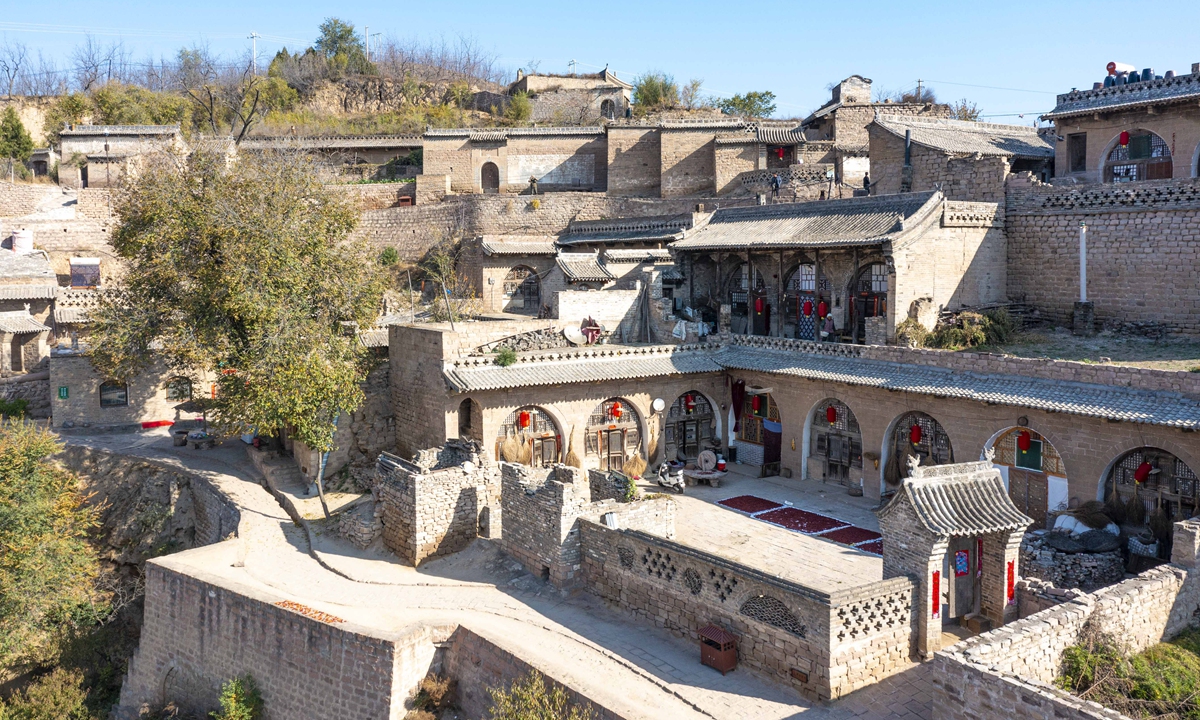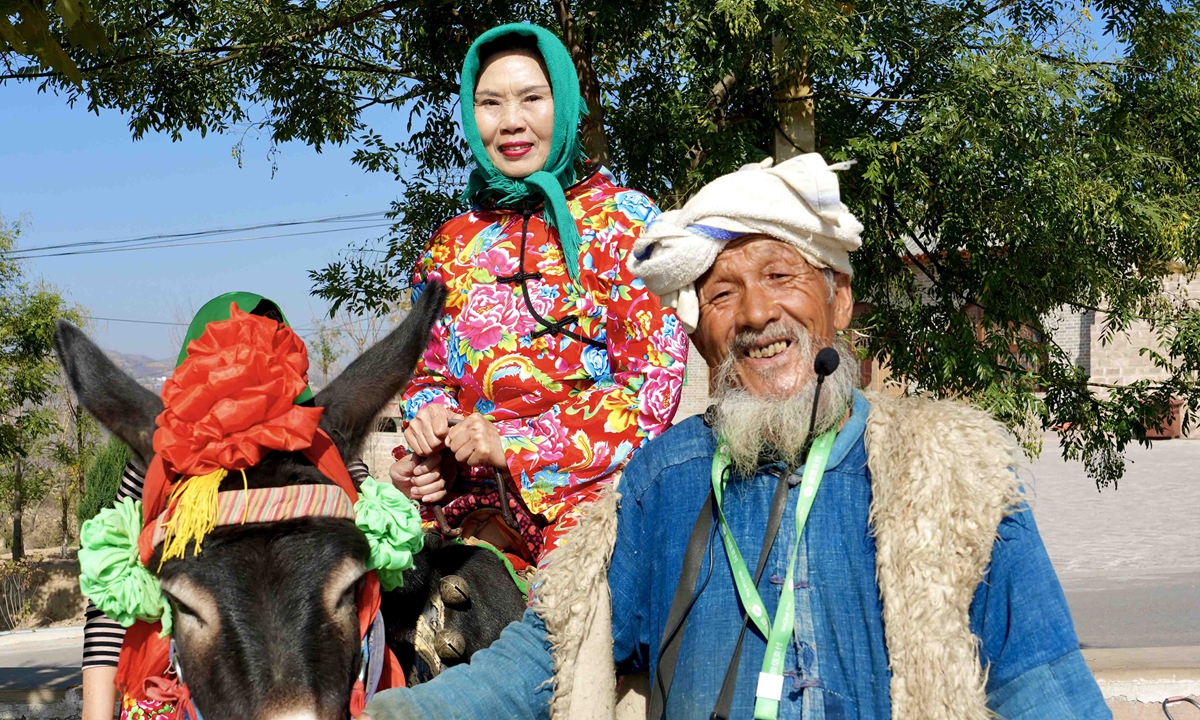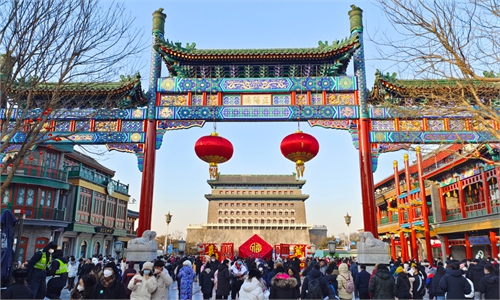IN-DEPTH / IN-DEPTH
Hometown witness: China’s coal capital Shanxi births new vitality with ancient charm
Cherishing the old, embracing the new
Editor's Note:
The world recently celebrated a splendid Chinese New Year, welcoming the Year of the Dragon.
During the holidays, Global Times reporters returned to their hometowns where they were reacquainted with old traditions and introduced to new post-pandemic experiences. To share their experience, we have launched the "Hometown Diary" series. Spanning from north to south, east to west, six articles will focus on different provinces, exploring the development and evolution from traditional to modern, and from economic to cultural dimensions.
This series is not only a comprehensive review of China's vast territory and diverse regional cultures but also a profound reflection of how different areas across the country maintain their identity and embrace changes.
Through the lens of hometown observations, we hope to touch the hearts of our readers, allowing everyone to find resonance in these stories and feel the warmth and vitality that hometowns provide, regardless of changes brought about by time.
This is the first installment in the series, in which we gain the perspectives of our reporters to understand how North China's Shanxi grabs cultural heritage to attract tourists after its green energy revolution, and how East China's Shandong strikes a balance between tradition and modernity amidst intense population mobility.

When it comes to North China's Shanxi Province, the first impressions are often "coal capital," "severe pollution," and "loess highland," with a perpetually dull skyline and miles of yellow soil. People have always believed that Shanxi was trapped in its monotonous identity as the "coal capital" and was unlikely to achieve innovation and reform.
However, recent changes have provided evidence to the contrary. Shanxi, my hometown, with its cultural traditions and ancient heritage, now boasts new calling cards.
A casual stroll will reveal historical relics in Shanxi. During the Spring Festival, while witnessing the bustling scenes of Shanxi's tourist attractions flooding the internet, I felt Shanxi's charm emerge from its enduring ancient glory that spans thousands of years. It is precisely the inheritance and continuation of tradition in Shanxi that is aiding its innovation.
Behind this lies the continuous efforts of the local government in environmental governance and high-quality tourism development.
New business cards drive new traffic
On February 8, my friend Li Bo and I visited the ancient picturesque village of Qikou located in western Shanxi's Lüliang, nestled along the banks of the Yellow River and once one of the most prosperous settlements in ancient China.
This ancient town does not rank among the top 10 famous tourist destinations in Shanxi, but its popularity was surprising in person.
The taxi driver told us that we were the sixth group of tourists he had driven to Qikou that day. The famous local noodle restaurant had a queue out the door as early as 11 am.
The village, with its traditional architecture nestled amidst rolling hills, exudes an aura of tranquility and timelessness. Travelers from all over the world pass through the ancient town, looking to experience the unique culture of the Yellow River Basin and the picturesque beauty of the ancient villages with distinctive northern characteristics. For example, 3D panoramic modeling vividly reproduces the classic patterns of Pingyao's lacquerware. Additionally, lifelike colored maidservant sculptures from the Song Dynasty (960 - 1279) at Jin Temple traverse time and space, gracefully dancing outside and interacting with visitors.
In order to protect them from flooding, many local houses, known as "yaodong" or "loess cave houses," have been physically carved into the steep hillside along the banks of the Yellow River.
On a slope that stretches for hundreds of meters and is inclined at a 40-degree angle, there are rows of cave dwellings arranged in layers, which are both scattered and unique in their own ways. Rock erosion over the years has created a form of beautiful "modern art."
In recent years, with enhanced efforts in cultural preservation, governments at all levels have continually increased investment in the restoration and protection of historical buildings and ancient residences in Qikou, promoting the integrated development of culture and tourism, and creating a "living ancient town." Ancient buildings such as tour guide agencies, pawnshops, and warehouses tell the story of the town's past prosperity.
During our visit, the scenic area had also launched traditional folk agricultural cultural performances, showcasing scenes of threshing, winnowing, and transplanting, vividly capturing the hardworking and agricultural spirit of their ancestors.
Yang Yanmei, 62, often uses her spare time as a tour guide along the paths of Qikou, telling stories of past generations. As a fan of traditional opera, she and her husband enjoy spontaneously singing Shanxi opera or local traditional melodies adapted from local stories.
When we arrived at her house, the audience attracted by her singing crowded the entrance, making it impossible to enter. She always wears a sincere and sanguine smile, impressing tourists with her simplicity and humor. My friend told me that this is the typical image of farmers living on the loess plateau in his mind.
Tour guides, guesthouse owners, restaurant owners, performers... more and more villagers have found their new passions through it. Some like Yang have even moved back to their ancestral homes in the mountains from the town, hoping to live a better and more vibrant life through tourism.
Local villagers told me that more than 5,000 people out of a population of about 30,000 in the town are engaged in the tourism industry.
"Entering the ancient town feels like stepping into a world of art, where some places resemble Western oil paintings, while others resemble Chinese ink paintings," said Li. "Shanxi is no longer the dull and gray place it used to be; it is much more colorful and vibrant than I imagined," exclaimed the guest.
The evolution of civilization has left Shanxi with over 28,000 ancient buildings, making it the province with the highest number of key cultural heritage sites in the country. Shanxi's cultural relics have a complete timeline and diverse categories, earning it the reputation of being the "treasury of ancient Chinese architecture."
It has many relic sites that include architecture, grottoes, houses, murals, and sculptures with distinct features. Pingyao Ancient City, a well-preserved 2,800-year-old ancient county-level city; Yungang Grottoes, with their 252 caves and 51,000 statues that represent the outstanding history of Buddhist cave art in China in the 5th and 6th centuries; and Mount Wutai, a temple complex that witnessed the 2,000-year history of Buddhism, are three major UNESCO World Heritage Sites in Shanxi Province.
Tickets to these attractions are hard to come by, with the average queuing time exceeding three hours during the just-concluded Spring Festival.
According to data from Ctrip, one of China's largest online travel agencies, tourism orders in Shanxi during the Spring Festival holidays increased 16-fold compared to the 2023.

Standing on the Loess Plateau in the Qikou ancient town, one can feel the unchanged spiritual core of Shanxi, which is still characterized by diligence, honesty, and humility. However, what has changed is their passion for innovation and their desire to promote their culture and heritage on both domestic and international stages.
Modern technology is widely utilized to support these ambitions. Some temples employ VR, AR, 5G, and other interactive technologies to present historical figures and stories in a three-dimensional (3D) manner to visitors.
In order to promote Shanxi's classical culture to the world, media reports indicate that from 2016 to 2020, Shanxi Province sent over 300 artists in 31 groups to more than 20 countries to engage in exchange activities, thereby expanding its overseas reputation.
Some of Shanxi's intangible cultural heritage brands have actively collaborated with foreign designers to create exquisite products that blend Eastern and Western elements, which have been well received in foreign markets.
Pioneer of clean energy
For children who grew up in the coal capital, "black mud lining the fingernails and nostrils" was our shared memory. But now, this is unimaginable for Li Bo. The Shanxi he sees is a pleasant place under the blue sky and white clouds, where people can leisurely experience the slow life of ancient cities.
Behind this obvious change lies the silent effort of the local government in environmental protection efforts.
In recent years, Shanxi has been forward-looking in developing future industries such as green hydrogen energy, new energy vehicles, and cutting-edge materials, gradually achieving a historic leap from being the "coal giant" to the "pioneer of the national energy revolution."
The renovation of old coal mines is also ongoing. Media reports show that Shanxi has built 118 intelligent coal mines, accounting for about 62 percent of the total coal production capacity in the province, greatly helping to improve local air quality.
According to government-provided data, by 2023, the province's ecological environment quality had significantly improved, ranking second in terms of improvement rate nationwide, reaching its best level in history. At the same time, the water ecological environment continues to strengthen, with 149.6 acres of artificial wetlands built and the proportion of excellent water bodies in the Yellow River Basin reaching 90 percent.
A beautiful picture of blue sky, green land, and clear water is slowly unfolding in the land of Shanxi.
The landlocked province is showcasing the beauty of time to the world with an understated and rustic charm. This energy-rich province, which supplies coal power to 14 provinces in China, is showing the world, in a softer way, that it can make many contributions beyond coal.
The world recently celebrated a splendid Chinese New Year, welcoming the Year of the Dragon.
During the holidays, Global Times reporters returned to their hometowns where they were reacquainted with old traditions and introduced to new post-pandemic experiences. To share their experience, we have launched the "Hometown Diary" series. Spanning from north to south, east to west, six articles will focus on different provinces, exploring the development and evolution from traditional to modern, and from economic to cultural dimensions.
This series is not only a comprehensive review of China's vast territory and diverse regional cultures but also a profound reflection of how different areas across the country maintain their identity and embrace changes.
Through the lens of hometown observations, we hope to touch the hearts of our readers, allowing everyone to find resonance in these stories and feel the warmth and vitality that hometowns provide, regardless of changes brought about by time.
This is the first installment in the series, in which we gain the perspectives of our reporters to understand how North China's Shanxi grabs cultural heritage to attract tourists after its green energy revolution, and how East China's Shandong strikes a balance between tradition and modernity amidst intense population mobility.

The ancient picturesque village Qikou located in Lüliang, western Shanxi Photo: Courtesy of Lu Pengyu
When it comes to North China's Shanxi Province, the first impressions are often "coal capital," "severe pollution," and "loess highland," with a perpetually dull skyline and miles of yellow soil. People have always believed that Shanxi was trapped in its monotonous identity as the "coal capital" and was unlikely to achieve innovation and reform.
However, recent changes have provided evidence to the contrary. Shanxi, my hometown, with its cultural traditions and ancient heritage, now boasts new calling cards.
A casual stroll will reveal historical relics in Shanxi. During the Spring Festival, while witnessing the bustling scenes of Shanxi's tourist attractions flooding the internet, I felt Shanxi's charm emerge from its enduring ancient glory that spans thousands of years. It is precisely the inheritance and continuation of tradition in Shanxi that is aiding its innovation.
Behind this lies the continuous efforts of the local government in environmental governance and high-quality tourism development.
New business cards drive new traffic
On February 8, my friend Li Bo and I visited the ancient picturesque village of Qikou located in western Shanxi's Lüliang, nestled along the banks of the Yellow River and once one of the most prosperous settlements in ancient China.
This ancient town does not rank among the top 10 famous tourist destinations in Shanxi, but its popularity was surprising in person.
The taxi driver told us that we were the sixth group of tourists he had driven to Qikou that day. The famous local noodle restaurant had a queue out the door as early as 11 am.
The village, with its traditional architecture nestled amidst rolling hills, exudes an aura of tranquility and timelessness. Travelers from all over the world pass through the ancient town, looking to experience the unique culture of the Yellow River Basin and the picturesque beauty of the ancient villages with distinctive northern characteristics. For example, 3D panoramic modeling vividly reproduces the classic patterns of Pingyao's lacquerware. Additionally, lifelike colored maidservant sculptures from the Song Dynasty (960 - 1279) at Jin Temple traverse time and space, gracefully dancing outside and interacting with visitors.
In order to protect them from flooding, many local houses, known as "yaodong" or "loess cave houses," have been physically carved into the steep hillside along the banks of the Yellow River.
On a slope that stretches for hundreds of meters and is inclined at a 40-degree angle, there are rows of cave dwellings arranged in layers, which are both scattered and unique in their own ways. Rock erosion over the years has created a form of beautiful "modern art."
In recent years, with enhanced efforts in cultural preservation, governments at all levels have continually increased investment in the restoration and protection of historical buildings and ancient residences in Qikou, promoting the integrated development of culture and tourism, and creating a "living ancient town." Ancient buildings such as tour guide agencies, pawnshops, and warehouses tell the story of the town's past prosperity.
During our visit, the scenic area had also launched traditional folk agricultural cultural performances, showcasing scenes of threshing, winnowing, and transplanting, vividly capturing the hardworking and agricultural spirit of their ancestors.
Yang Yanmei, 62, often uses her spare time as a tour guide along the paths of Qikou, telling stories of past generations. As a fan of traditional opera, she and her husband enjoy spontaneously singing Shanxi opera or local traditional melodies adapted from local stories.
When we arrived at her house, the audience attracted by her singing crowded the entrance, making it impossible to enter. She always wears a sincere and sanguine smile, impressing tourists with her simplicity and humor. My friend told me that this is the typical image of farmers living on the loess plateau in his mind.
Tour guides, guesthouse owners, restaurant owners, performers... more and more villagers have found their new passions through it. Some like Yang have even moved back to their ancestral homes in the mountains from the town, hoping to live a better and more vibrant life through tourism.
Local villagers told me that more than 5,000 people out of a population of about 30,000 in the town are engaged in the tourism industry.
"Entering the ancient town feels like stepping into a world of art, where some places resemble Western oil paintings, while others resemble Chinese ink paintings," said Li. "Shanxi is no longer the dull and gray place it used to be; it is much more colorful and vibrant than I imagined," exclaimed the guest.
The evolution of civilization has left Shanxi with over 28,000 ancient buildings, making it the province with the highest number of key cultural heritage sites in the country. Shanxi's cultural relics have a complete timeline and diverse categories, earning it the reputation of being the "treasury of ancient Chinese architecture."
It has many relic sites that include architecture, grottoes, houses, murals, and sculptures with distinct features. Pingyao Ancient City, a well-preserved 2,800-year-old ancient county-level city; Yungang Grottoes, with their 252 caves and 51,000 statues that represent the outstanding history of Buddhist cave art in China in the 5th and 6th centuries; and Mount Wutai, a temple complex that witnessed the 2,000-year history of Buddhism, are three major UNESCO World Heritage Sites in Shanxi Province.
Tickets to these attractions are hard to come by, with the average queuing time exceeding three hours during the just-concluded Spring Festival.
According to data from Ctrip, one of China's largest online travel agencies, tourism orders in Shanxi during the Spring Festival holidays increased 16-fold compared to the 2023.

A villager in Qikou ancient town in North China's Shanxi leads his donkey carrying visitors through the town. Photo: Courtesy of Lu Pengyu
Step to a bigger stageStanding on the Loess Plateau in the Qikou ancient town, one can feel the unchanged spiritual core of Shanxi, which is still characterized by diligence, honesty, and humility. However, what has changed is their passion for innovation and their desire to promote their culture and heritage on both domestic and international stages.
Modern technology is widely utilized to support these ambitions. Some temples employ VR, AR, 5G, and other interactive technologies to present historical figures and stories in a three-dimensional (3D) manner to visitors.
In order to promote Shanxi's classical culture to the world, media reports indicate that from 2016 to 2020, Shanxi Province sent over 300 artists in 31 groups to more than 20 countries to engage in exchange activities, thereby expanding its overseas reputation.
Some of Shanxi's intangible cultural heritage brands have actively collaborated with foreign designers to create exquisite products that blend Eastern and Western elements, which have been well received in foreign markets.
Pioneer of clean energy
For children who grew up in the coal capital, "black mud lining the fingernails and nostrils" was our shared memory. But now, this is unimaginable for Li Bo. The Shanxi he sees is a pleasant place under the blue sky and white clouds, where people can leisurely experience the slow life of ancient cities.
Behind this obvious change lies the silent effort of the local government in environmental protection efforts.
In recent years, Shanxi has been forward-looking in developing future industries such as green hydrogen energy, new energy vehicles, and cutting-edge materials, gradually achieving a historic leap from being the "coal giant" to the "pioneer of the national energy revolution."
The renovation of old coal mines is also ongoing. Media reports show that Shanxi has built 118 intelligent coal mines, accounting for about 62 percent of the total coal production capacity in the province, greatly helping to improve local air quality.
According to government-provided data, by 2023, the province's ecological environment quality had significantly improved, ranking second in terms of improvement rate nationwide, reaching its best level in history. At the same time, the water ecological environment continues to strengthen, with 149.6 acres of artificial wetlands built and the proportion of excellent water bodies in the Yellow River Basin reaching 90 percent.
A beautiful picture of blue sky, green land, and clear water is slowly unfolding in the land of Shanxi.
The landlocked province is showcasing the beauty of time to the world with an understated and rustic charm. This energy-rich province, which supplies coal power to 14 provinces in China, is showing the world, in a softer way, that it can make many contributions beyond coal.


